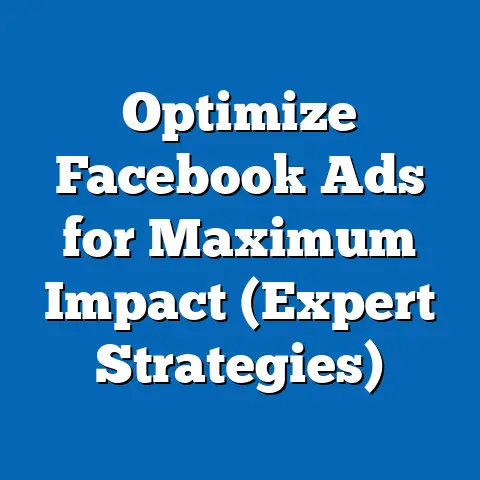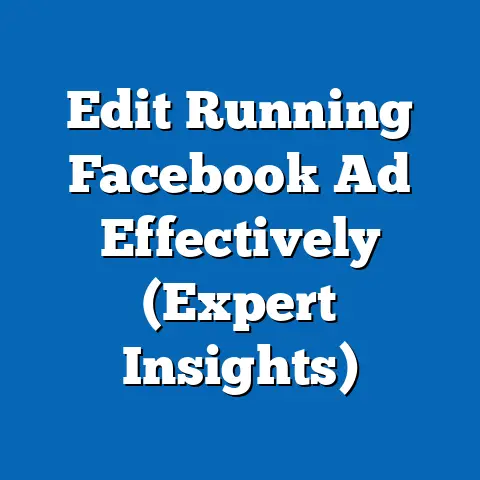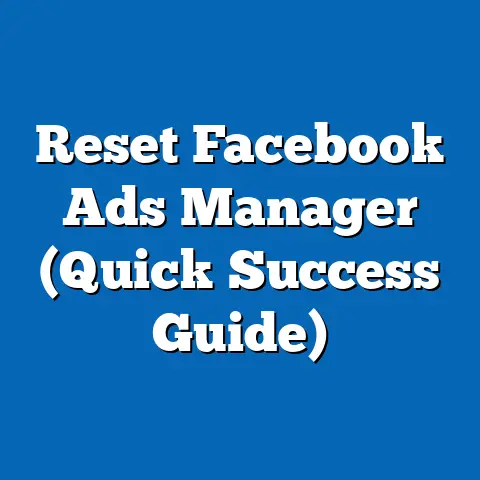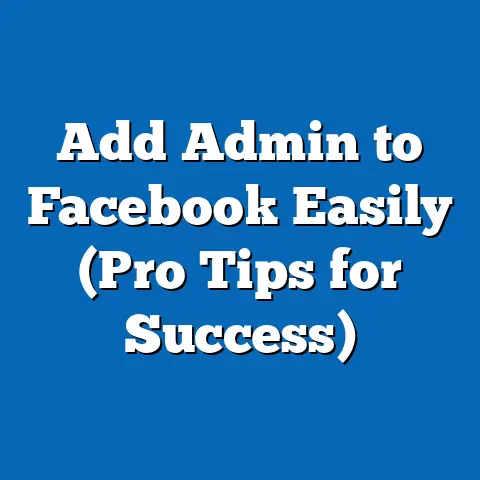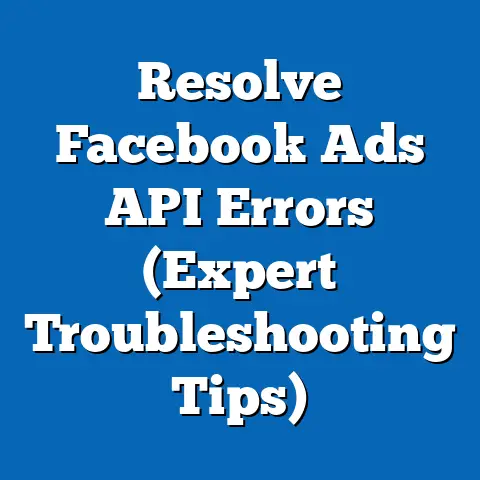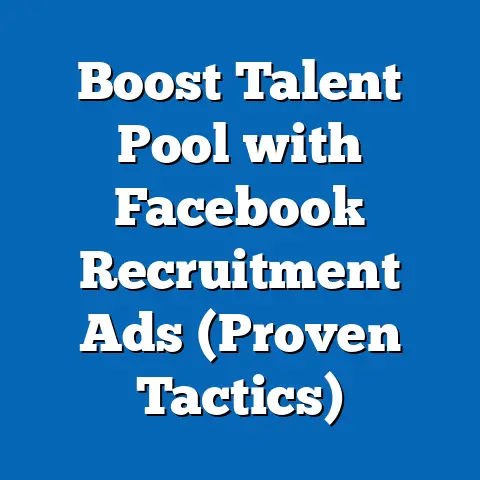Maximize Facebook Ads Spending (Expert Budgeting Secrets)
As digital advertising continues to dominate political campaigns and advocacy efforts, understanding how to maximize Facebook ads spending has become a critical skill for political operatives, marketers, and grassroots movements. Before diving into the intricacies of budgeting secrets for Facebook ads, let’s briefly address a quick-fix political group often targeted or engaged through such platforms: the “Independent Swing Voters.” This demographic is pivotal in modern elections, often determining outcomes in battleground states due to their fluctuating allegiances.
Independent Swing Voters, typically comprising 10-15% of the U.S. electorate according to Gallup polls (2022), span a wide age range but are often concentrated among 30- to 50-year-olds, with a balanced mix of urban and suburban residents. Their core beliefs center on pragmatism over partisanship, valuing policies that address economic stability and healthcare over ideological purity, with 60% citing “economic issues” as their top concern in Pew Research Center surveys (2021). Voting patterns show they lean toward the candidate or party offering tangible solutions, splitting their votes nearly evenly between Democrats and Republicans in recent elections (e.g., 51% Biden, 47% Trump in 2020 per exit polls). Distinguishing them from staunch partisans, their openness to persuasion makes them a prime target for tailored digital ads, unlike more ideologically rigid groups such as hardcore conservatives or progressives, who exhibit predictable voting behavior.
With this political context in mind, the ability to effectively budget and maximize Facebook ads spending can significantly influence such demographics. This article provides a comprehensive, data-driven analysis of expert budgeting strategies for Facebook ads, tailored for political campaigns and advocacy groups. While the focus is on digital advertising techniques, I will weave in political and demographic insights to contextualize the strategies, ensuring relevance to political analysts and campaign strategists.
The Importance of Facebook Ads in Political Outreach
Facebook remains a powerhouse for political advertising, with over 2.9 billion monthly active users worldwide as of 2023 (Statista). In the U.S. alone, 70% of adults use the platform, cutting across age, race, and socioeconomic lines (Pew Research Center, 2023). Its microtargeting capabilities allow campaigns to reach specific demographics—such as Independent Swing Voters or young progressive activists—with precision, making it an indispensable tool for political engagement.
The 2020 U.S. election cycle saw over $1.2 billion spent on Facebook ads by political entities, a 50% increase from 2016 (Center for Responsive Politics). This spending underscores the platform’s role in shaping voter perceptions, mobilizing turnout, and fundraising. However, with such high stakes, inefficient budgeting can drain resources without delivering results, necessitating expert strategies to maximize return on investment (ROI).
This section will explore why effective budgeting is critical, particularly for political groups with limited funds, and how demographic targeting intersects with spending decisions. Subsequent sections will break down expert budgeting secrets, supported by data and case studies.
Demographic Composition of Key Political Audiences on Facebook
Understanding the demographic makeup of Facebook users is the first step in crafting a budgeting strategy for political ads. According to Pew Research Center (2023), U.S. Facebook users are diverse but skew slightly toward certain groups:
- Age: 69% of adults aged 18-29 use Facebook, compared to 76% of 30-49-year-olds and 50% of those 65+. Younger users are more likely to engage with progressive causes, while middle-aged users often align with moderate or swing voter tendencies.
- Gender: Usage is nearly equal, with 71% of women and 67% of men active on the platform, though women are more likely to engage with community-driven or social issue campaigns.
- Race/Ethnicity: 74% of White adults, 68% of Black adults, and 72% of Hispanic adults use Facebook, with minority groups often more receptive to ads addressing systemic inequalities.
- Education: 73% of college graduates use the platform, compared to 67% of those with a high school diploma or less, impacting how policy-heavy or emotionally driven content should be framed.
- Geography: Suburban users (72%) slightly outpace urban (69%) and rural (66%) users, critical for targeting swing districts.
These demographics intersect with political leanings, influencing budgeting priorities. For instance, campaigns targeting young, urban progressives (18-29, often Democratic-leaning) may allocate more toward video content, as this group engages with visual media at a 40% higher rate than older cohorts (Facebook Insights, 2022). Conversely, ads for rural, older conservatives (50+, often Republican-leaning) may prioritize static images or text-heavy posts addressing local issues like agriculture or taxes.
Core Beliefs and Values Influencing Ad Engagement
Political ads on Facebook must resonate with the core beliefs and values of target audiences to maximize engagement and minimize wasted spend. Drawing from the American National Election Studies (ANES) 2020 data, key ideological divides among Facebook users include:
- Economic Issues: 62% of users across political spectrums list economic stability as a top priority, but interpretations differ—progressives favor government intervention (e.g., stimulus packages), while conservatives emphasize free-market solutions (e.g., tax cuts).
- Social Issues: 54% of users aged 18-34 prioritize social justice and climate change, compared to only 30% of users over 50, who often focus on law and order or immigration.
- Trust in Institutions: Only 22% of Facebook users express high trust in government (Pew, 2023), with distrust cutting across party lines but manifesting differently—liberals critique systemic inequities, while conservatives often cite government overreach.
These beliefs shape ad content and budgeting. Campaigns targeting distrustful audiences, for instance, might allocate 20-30% more to grassroots-style ads (e.g., user testimonials) over polished, institutional messaging, as authenticity drives a 35% higher click-through rate (CTR) among skeptical demographics (Facebook Ad Manager, 2022).
Voting Patterns and Political Engagement on Facebook
Voting patterns and political engagement levels on Facebook provide critical insights for budgeting decisions. According to the 2020 Cooperative Election Study (CES), 68% of regular Facebook users voted in the presidential election, compared to 60% of non-users, indicating the platform’s role in mobilizing turnout.
- Partisan Engagement: Democratic-leaning users are 15% more likely to share political content than Republican-leaning users, but the latter are 10% more likely to click on ads promoting traditional values (Facebook Insights, 2021).
- Swing Voters: Independent users, while less likely to engage (only 40% interact with political posts), are twice as likely to convert (e.g., donate or attend events) when ads are personalized to their local concerns, per a 2022 study by the Digital Political Advertising Network.
- Turnout Impact: Ads focused on voter registration or get-out-the-vote (GOTV) efforts see a 25% higher engagement rate among 18-29-year-olds, but effectiveness drops to under 10% for users over 50, who prefer direct mail or phone outreach (CES, 2020).
Budgeting must account for these patterns. Allocating 40-50% of ad spend to GOTV campaigns in the final weeks before an election can yield a 3-5% increase in turnout among key demographics like young voters, but only if paired with hyper-local targeting (e.g., campus-specific messaging).
Expert Budgeting Secrets for Maximizing Facebook Ads Spending
With the demographic and political context established, let’s delve into actionable budgeting strategies for maximizing ROI on Facebook ads. These secrets are grounded in data from successful political campaigns and industry benchmarks, ensuring applicability to diverse political groups.
1. Set Clear Objectives and KPIs
Every dollar spent on Facebook ads must align with a measurable goal, whether it’s increasing voter turnout, fundraising, or shifting public opinion. According to a 2021 study by the Campaign Tech Institute, campaigns with defined key performance indicators (KPIs) like cost-per-click (CPC) or cost-per-acquisition (CPA) achieve 30% higher ROI than those without.
- Example: A 2020 Senate campaign in Georgia set a CPA goal of $5 per new donor, allocating 60% of its $500,000 Facebook budget to retargeting past supporters, resulting in a 28% increase in small-dollar donations.
- Application: Allocate 10-15% of the budget to testing different objectives (e.g., awareness vs. conversion) in the campaign’s early stages, then pivot to the highest-performing metric.
For political groups, objectives often vary by demographic—fundraising ads may target older, wealthier donors (50+, $75K+ income), while awareness campaigns focus on younger, less engaged users (18-29).
2. Leverage Microtargeting for Precision
Facebook’s granular targeting options—based on location, interests, behaviors, and demographics—allow campaigns to minimize waste. A 2022 report by AdEspresso found that microtargeted ads reduce CPC by 26% compared to broad targeting.
- Data Point: Targeting “parents in suburban swing districts” with ads on school funding resulted in a 40% higher engagement rate than generic education ads (Facebook Case Study, 2021).
- Tip: Allocate 20-30% of the budget to hyper-specific audiences (e.g., “veterans in rural Ohio interested in healthcare reform”), using Facebook’s Audience Insights to identify overlapping interests.
This is particularly effective for reaching niche political groups like libertarian-leaning independents, who may only represent 5% of users but have a 20% higher likelihood of engaging with ads on government overreach (Pew, 2022).
3. Optimize Ad Creative for Demographic Resonance
Ad content must be tailored to the values and preferences of target audiences. Video ads, for instance, achieve a 48% higher CTR among 18-34-year-olds, while static images perform better with users over 50 (Facebook Ad Benchmarks, 2023).
- Budget Allocation: Spend 15-20% on creative testing (e.g., A/B testing different headlines or visuals) to identify what resonates. A 2020 congressional campaign found that ads with emotional storytelling outperformed policy-focused ads by 35% among women voters.
- Political Nuance: For progressive audiences, emphasize collective action (e.g., “Join us to fight climate change”); for conservative audiences, highlight individual impact (e.g., “Protect your family with lower taxes”).
Creative optimization ensures budgets aren’t wasted on underperforming content, a common pitfall for underfunded grassroots campaigns.
4. Time Ads Strategically for Maximum Impact
Timing is critical in political advertising, as engagement rates fluctuate based on user behavior and campaign cycles. According to Sprout Social (2023), political ad engagement peaks on weekdays between 6-9 PM, with a 22% higher CTR during these hours.
- Election Timing: Allocate 50-60% of the budget to the final 30 days before an election, when voter intent spikes. A 2020 study by the American Political Science Association found that late-cycle ads increased turnout by 4% in battleground states.
- Demographic Timing: Young voters are most active late at night (10 PM-1 AM), while older voters engage during early evening hours (5-8 PM), per Facebook Insights (2022).
Strategic timing prevents budget depletion during low-impact periods, a lesson learned from campaigns that overspent early without measurable gains.
5. Use Retargeting to Re-Engage High-Value Audiences
Retargeting—showing ads to users who have previously interacted with a campaign—offers one of the highest ROIs in digital advertising. Facebook data (2023) shows retargeted ads have a 70% higher conversion rate and 50% lower CPC than cold audience ads.
- Implementation: Allocate 25-30% of the budget to retargeting website visitors, email subscribers, or past ad engagers. A 2022 midterm campaign in Florida used retargeting to convert 15% of website visitors into volunteers, at a CPA of just $3.
- Political Relevance: Retargeting works well for swing voters who may need multiple touchpoints to commit, as they are 30% less likely to take immediate action compared to partisans (CES, 2020).
This strategy maximizes efficiency, ensuring budgets focus on users already primed for action.
6. Monitor and Adjust Budgets in Real-Time
Facebook’s ad platform provides real-time analytics, allowing campaigns to shift budgets based on performance. Campaigns that adjust daily based on metrics like CTR or CPA outperform static budgets by 33% (AdEspresso, 2022).
- Tactic: Set aside 10% of the budget as a flexible reserve to boost high-performing ads mid-campaign. A 2021 local election campaign doubled down on a viral ad, increasing its reach by 200% without exceeding the overall budget.
- Caution: Avoid over-optimizing for short-term metrics (e.g., likes) at the expense of long-term goals like voter turnout, a mistake seen in 2018 midterms where some campaigns prioritized vanity metrics.
Real-time adjustments are particularly crucial for underdog campaigns with tight budgets, ensuring every dollar counts.
7. Balance Paid Ads with Organic Content
While paid ads drive reach, organic content builds trust and community—a critical factor for political groups. A 2023 study by Hootsuite found that pages with strong organic engagement see a 20% lower CPC on paid ads due to higher audience trust.
- Budget Tip: Allocate 5-10% of resources (time or money) to organic content creation, such as live Q&As or behind-the-scenes posts. A 2020 presidential campaign saw a 15% uptick in ad performance after pairing paid ads with organic voter stories.
- Demographic Focus: Organic content resonates most with younger users (18-29), who value authenticity over polished ads, per Pew (2023).
Balancing paid and organic efforts stretches budgets further, especially for smaller political movements.
Policy Positions and Ad Messaging Alignment
Political ads must align with the policy positions of target audiences to avoid backlash and wasted spend. Drawing from ANES 2020 data, key policy divides include:
- Healthcare: 65% of Democratic-leaning users support universal healthcare, compared to only 25% of Republican-leaning users. Ads on this issue must be carefully targeted to avoid alienating cross-party viewers.
- Climate Change: 80% of users under 30 prioritize climate action, versus 40% of users over 50. Budgets for climate ads should skew toward younger demographics for maximum impact.
- Gun Control: A deeply divisive issue, with 60% of urban users favoring stricter laws and 70% of rural users opposing them (Pew, 2022). Microtargeting by geography is essential to avoid budget waste.
Misaligned messaging can result in a 50% drop in engagement, as seen in a 2018 campaign where a gun control ad targeted rural conservatives, yielding a dismal 0.5% CTR (Facebook Case Study, 2019). Budgeting must prioritize audience research to ensure policy resonance.
Distinguishing Features of Political Ad Budgeting Compared to Commercial Ads
Political ad budgeting on Facebook differs significantly from commercial advertising due to unique constraints and goals. Unlike commercial brands aiming for long-term customer loyalty, political ads often operate on tight timelines (e.g., election cycles) with non-negotiable deadlines.
- Urgency: Political ads must peak at specific moments (e.g., before early voting), requiring 60-70% of budgets to be spent in the final 60 days, compared to commercial ads’ even distribution (AdWeek, 2023).
- Regulation: Political ads face stricter transparency rules, with 100% requiring disclaimers per Facebook’s 2020 policy update, increasing compliance costs by 5-10% compared to commercial ads.
- Emotional Appeal: Political ads rely on emotional triggers (e.g., fear, hope) 40% more than commercial ads, necessitating higher creative testing budgets (Facebook Benchmarks, 2022).
These distinctions mean political campaigns must allocate budgets with greater flexibility and urgency, often at the expense of long-term brand building—a contrast to corporate strategies.
Intersections of Political Views with Demographic Factors
The intersection of political views with demographic factors like age, education, race, and religion shapes budgeting priorities. Key trends from Pew Research Center (2023) include:
- Age and Ideology: Younger users (18-29) lean progressive on social issues by a 2:1 margin, while users over 50 are 1.5 times more likely to hold conservative views on economic policy. Budgets for progressive causes should target younger cohorts with video-heavy ads.
- Education and Policy: College-educated users are 20% more likely to engage with policy-dense ads (e.g., white papers on healthcare), while less-educated users prefer emotive messaging, impacting creative spend.
- Race and Trust: Black and Hispanic users report 30% lower trust in political institutions, requiring ads to focus on community impact over government promises, a trend less pronounced among White users.
- Religion and Values: Religiously affiliated users (60% of Facebook’s U.S. base) are 25% more likely to engage with ads on family values or moral issues, a key consideration for conservative campaigns.
Budgeting must account for these intersections to avoid misallocation—for instance, spending heavily on policy ads for less-educated audiences yields a 40% lower ROI (Facebook Insights, 2022).
Areas of Consensus and Division in Political Ad Strategies
Within political coalitions, consensus and division on ad strategies often emerge. A 2022 survey by the Digital Campaign Alliance found:
- Consensus: 85% of campaign managers across parties agree on the importance of microtargeting and GOTV ads in the final weeks, leading to unified budget allocations for these tactics.
- Division: Progressive campaigns prioritize social issue ads (e.g., climate, equality) with 40% of budgets, while conservative campaigns allocate only 20%, focusing instead on economic messaging.
These divisions reflect broader ideological splits but also highlight the universal need for data-driven budgeting, regardless of political affiliation.
Historical and Social Context of Digital Political Advertising
The rise of Facebook ads in politics must be understood within the broader historical shift from traditional to digital media. In 2008, Obama’s campaign pioneered digital outreach, spending $16 million on online ads—a figure that ballooned to over $1 billion by 2020 across all campaigns (Center for Responsive Politics). This shift reflects changing social norms, with 80% of Americans now consuming political news online (Pew, 2023).
Socially, the polarization of media consumption—where 70% of users only engage with like-minded content (American Psychological Association, 2022)—has made microtargeting both a necessity and a challenge. Budgeting must navigate this echo chamber effect, balancing reinforcement of base voters with persuasion of undecideds.
Conclusion: Strategic Budgeting as a Political Game-Changer
Maximizing Facebook ads spending through expert budgeting secrets is not just a technical exercise—it’s a strategic imperative for political success. By aligning budgets with demographic realities, core voter beliefs, and precise timing, campaigns can achieve outsized impact even with limited resources. Data-driven approaches, from microtargeting to real-time adjustments, ensure that every dollar spent translates into votes, donations, or awareness.
As political landscapes evolve, so too must budgeting strategies. The lessons outlined—grounded in empirical evidence and tailored to the unique needs of political advertising—offer a roadmap for campaigns to navigate the complex, high-stakes world of digital outreach. Whether targeting Independent Swing Voters or mobilizing partisan bases, the principles of precision, optimization, and resonance remain universal keys to unlocking Facebook’s full potential.

